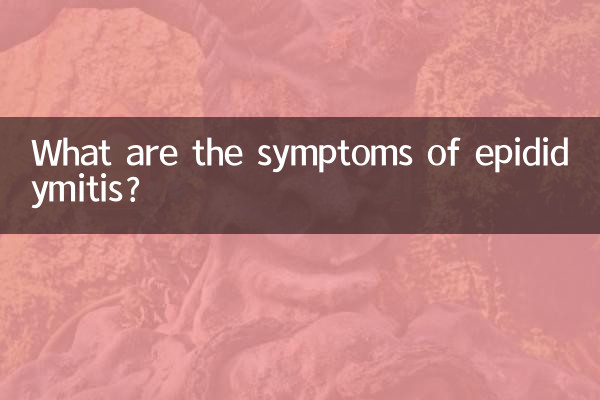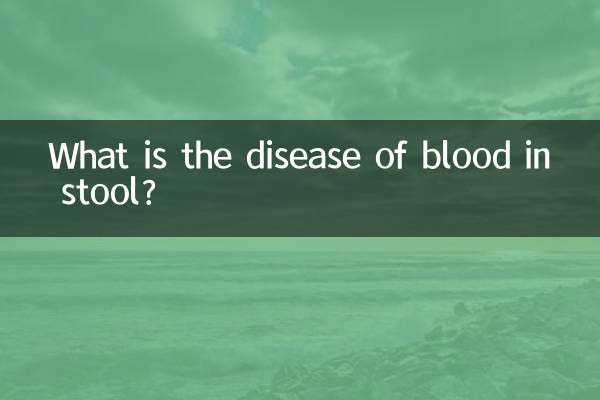What are the symptoms of epididymitis?
Epididymitis is one of the common inflammations of the male reproductive system. It is usually caused by bacterial infection and may be accompanied by symptoms such as testicular pain and swelling. In recent years, topics related to epididymitis have continued to gain popularity in the health field, especially discussions about its symptoms, treatment, and prevention. This article will combine the hot topics on the Internet in the past 10 days to provide you with a detailed analysis of the symptoms, causes and countermeasures of epididymitis.
1. The main symptoms of epididymitis

Typical symptoms of epididymitis include the following:
| symptom | describe |
|---|---|
| scrotal pain | The pain usually starts on one side, gets progressively worse, and may radiate to the groin or lower abdomen. |
| swelling | The epididymal area is significantly swollen and feels hard when touched. |
| fever | Some patients may develop low-grade or high-grade fever, accompanied by chills. |
| Abnormal urination | Urinary system symptoms such as frequent urination, urgency, and painful urination. |
| secretions | Some patients may develop urethral discharge, especially epididymitis caused by bacterial infection. |
2. Common causes of epididymitis
There are many causes of epididymitis, the following are some common causes:
| Cause | illustrate |
|---|---|
| bacterial infection | The most common causes are Escherichia coli, Neisseria gonorrhoeae, etc. |
| urinary tract infection | Bacteria retrogradely infect the epididymis through the urethra. |
| sexually transmitted diseases | Such as chlamydia, mycoplasma, etc. |
| other factors | Such as trauma, long-term indwelling urinary catheter, etc. |
3. Diagnosis and treatment of epididymitis
The diagnosis of epididymitis usually requires a combination of clinical symptoms and medical examination. The following are common diagnostic and treatment modalities:
| diagnostic methods | Treatment measures |
|---|---|
| Physical examination | Doctors use palpation to determine swelling and tenderness of the epididymis. |
| Urine test | The urine is tested for white blood cells and bacteria. |
| Ultrasound examination | Rule out testicular torsion or other pathology. |
| antibiotic treatment | Select sensitive antibiotics based on the pathogen. |
| Pain relief and anti-inflammatory | Use NSAIDs to relieve pain and swelling. |
4. How to prevent epididymitis
The key to preventing epididymitis is to avoid infection and maintain good living habits:
| Precautions | Specific methods |
|---|---|
| Pay attention to hygiene | Keep your vulva clean to avoid bacterial infections. |
| safe sex | Use condoms to reduce the risk of sexually transmitted diseases. |
| Treat urinary tract infections promptly | Avoid spreading bacteria to the epididymis. |
| Avoid sitting for long periods of time | Reduce vaginal compression and improve local blood circulation. |
5. Recent hot topics
In the past 10 days, discussions about epididymitis have mainly focused on the following aspects:
1.The relationship between epididymitis and infertility: Some studies have pointed out that recurrent epididymitis may affect sperm quality and lead to infertility.
2.Home care for epididymitis: Many netizens shared how to relieve symptoms through cold compresses, raising the scrotum, etc.
3.Antibiotic resistance problem: Some patients report poor treatment effects, which may be related to the abuse of antibiotics.
4.TCM treatment of epididymitis: Some traditional Chinese medicine prescriptions have been mentioned, but their efficacy has not been widely proven.
Conclusion
Although epididymitis is common, prompt diagnosis and treatment can effectively avoid complications. If you experience relevant symptoms, it is recommended to seek medical advice as soon as possible and never self-medicate. At the same time, maintaining good living habits and hygiene habits is the key to preventing epididymitis.

check the details

check the details